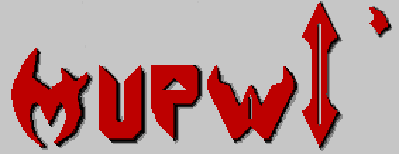

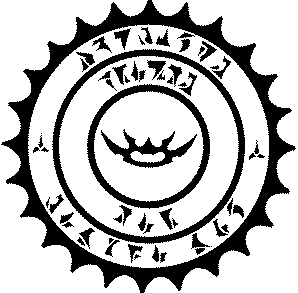
I welcome all of you who appreciate the seductive curves and radiant warmth of steel fashioned into the perfect Klingon blade - the betleH vaQqu' !! Whether you are fortunate enough to create your own custom weapons, aspire to learn the art or just want to associate with blade-smiths, *The Guild* is here to serve you and the Empire.
Once again we have new members to welcome. The Guild is really starting to take form and because of that I felt we should have an additional project running. The Battleaxe is a glorious project but probably too much for a novice to tackle. I will start a smaller knife project this month and use it to go step by step through the process of knife making for the members who are new to the craft and want to get started on their own blades. For the Warrior's knife which this project will involve I am using my standard quarter inch stock, but the pattern can be reduced in size and smaller stock substituted. You can also forgo some of the details in the blade such as the *cut-out*. At any rate this will be covered in that section.
I got a copy of the latest *Star Trek Communicator* because it had a large section devoted to Klingons. There is an article in it by the honorable Terry Ray Hiller who is a trained design analyst. He makes some observations that I think we all can benefit from. The points he brings up concerning Klingon design are ones that I have tried to stress in the blades that I make. The following is quoted from the Dec/Jan issue of the "Star Trek Communicator" , article by Terry Ray Hiller.
"Klingons value facing their enemies in combat. While they have photon torpedoes, disruptors, and any number of hi-tech weapons at their disposal, Klingons still prefer the traditional weapons of their low-tech ancestors for personal combat - the bat'leth and the d'k tahg"............"to engage an enemy without confrontation would not have appealed to the Klingon sense of ethics."
"Klingon esthetics reflect these deeply held beliefs and behaviors. Unlike the smooth lines incorporated into Federation objects, sharp angles and over sized elements distinguish Klingon design with an abiding fascination with points and blade-like edges." (Does this sound like any of *us*?) "More over, simplicity and straight forwardness are key Klingon esthetic ideals. Calling on the metaphor of hunting birds, Klingon visual design stresses four elements : strength, simplicity, power and danger."
STRENGTH, SIMPLICITY, POWER and DANGER
Lets get started.
I hope you enjoy it. As always your comments and input are welcome.
mupwI' yI'uchtaH !! (Keep holding the hammer ! )
K'Daq son of Toragh
Master of the Heart of Kri'stak


As the Guild grows, we will try to enhance camaraderie by publishing histories of our members (both Klingon and Terran). It is not necessary to develop a family history to be a Guild member, but it does help to solidify an image of you as a fellow crafts person and Klin.
House Kale has a long history that dates back to pre-spacefaring
days
of the empire .
House Kale is not a large house but has much honor.
Recently things have not gone well for House Kale. My "Father"
dishonored our house by his cowardly retreat in battle. He was
killed
when challenged by the first officer of the bird of prey he
commanded -
for his cowardice he died and now Morac is head of house and is
considering joining house Kassara.
.
Morac of the House of Kale
Honored Morac,
The honor of a House is based entirely on the one who leads that House. The blot placed on the House of Kale by your father will be erased by the songs of his most honorable son. You have the strength to lead your House but these are times of great unrest in the Empire. There is strength in numbers and House Kasara certainly has strength. You and I are not so different. I was led to House Kasara when my House was depleted by treachery and now you face a similar choice. Your heritage and who you are as a warrior will always remain no matter what house is honored to call you it's own.
K'Daq
Next month: House Kasara

The first accounting is well known but it is a tale that deserves telling. In it Kahless walked from the camps of his army prior to the final battle with Molar. He was troubled - the weight of thousands of warrior's lives was getting too much to bear and he had to have quiet to contemplate the situation. After sitting down under a small tree he fell into a troubled sleep and was met with a vision. The Gods told him to climb the slopes of Kri'stak , take a lock of his long black hair and dip it into the lava of the volcano . This was to be plunged into the waters of Lursor and a weapon of great power was to be forged from this. The God's gave him the vision of the sword and Kahless forged it as he was instructed, giving it the name bat'leth - *Sword of Honor*.
Molar was defeated and the bat'leth became not only the symbol, but the primary weapon of the warriors of the Empire.
The second accounting involves the recovery of some ancient documents written in Kahless's own hand. Although many tried to suppress them, the contents did become known and the story they tell not only honors Kahless as a leader, but as a man we can all admire and respect. God-hood is a terrible onus. Gods are to be feared but warriors of great strength and courage are to be admired and respected - that's what Kahless is and means to the Klingon Empire.
In this accounting Kahless still walks from camp and has his dream, but his first reaction is to gaze up at Kri'stak and laugh at the ridiculous idea of climbing the slopes of an active volcano. He does believe that the design of the bat'leth is divine in nature and he hurries back to camp to locate a metal smith. When the call is sent out for the best weapons maker in camp it is answered by Toragh, who makes Kahless his weapon and Molar is defeated.
This is the heritage of the weapons smith as well as the story of the bat'leth. We who make weapons are warriors first, for who can make a weapon if he does not first understand how to use it ? Great weapons are made by great weapons makers but great warriors are born to the task
Qa'Pla!!!
mupwI' yI'uchtaH !!

The standard bat'leth is one meter long (39 inches) from primary tip to primary tip and 27 inches long from secondary tip to secondary tip. The arch from the back of the center grip to the tip of the primary blades is 15.5 inches deep. So it fills a rectangle 39 X 15.5 inches. Mine is made of quarter inch stock.
OK a moment about blade thickness. I have made swords for a long time and historically and practically a quarter inch is the optimum thickness. You can get away with 3/16 on marginally small blades (small bat'leths and meqleths) but on larger swords you need the bulk to give you a blade that won't be easily deflected. In smaller pieces like knives I like quarter inch because of the *depth* it gives the piece. In this case its partially esthetics and partially function. A thick knife feels powerful in your grip.
In sizing your work the primary factor is the width of the warrior's shoulders. I have the warrior stand with arms outstretched and fists clenched with thumbs pointed inward. The measurement from the middle finger knuckle to middle finger knuckle corresponds to the measurement from the center of the one outboard cut-out to the other. Each cut-out should be pretty much similar but when you make adjustments to a final width the central opening will sometimes be changed to accommodate the size.
Next to consider is the stature of the warrior. Short warriors will require a smaller measurement in the width. This sometimes translates into an overall smaller sword but there are cases where the warrior has broad shoulders and is short in which case I usually make the arch (depth) greater to maintain optimum striking capability while reducing from the 39 inches. The same is true for taller warriors. If you have a warrior who is slender in the shoulders but tall you need to flatten the main blade arch and probably lengthen them as well.
*!*!*!* Never suggest that a sword be made smaller merely because the warrior is a female - you might end up being fed your own liver. When I reflect on the warriors that I would have at my side on the final days, the majority of them are women. A wild eyed Klingon woman with an axe - now that's a sight that would send shivers up a Jem Hidar's spine
Finally you must consider fighting style. Some warriors are slashers, some are stabbers, some are punchers etc., etc., etc. It is a plus to observe the warrior going thru standard bat'leth *stations* to make a determination on how the weapon will arch in his/her hands. Ideally I like the arch of the weapon to coincide with the arch along which the warrior swings his/her blade.
I have a plexiglass test bat'leth that I use to fit a warrior to the blade. I can make grease pencil measurements on it and also have a chance to watch it being swung . This is a great tool to use prior to drafting the final design. Remember that in most cases we aren't talking about radical differences in design here - a few inches at most generally take into account most shoulder types, and flattening the curve of the blade is not going to involve more than a few inches at most either. I like to maintain a constant width between primary and secondary blade points of about 6 to 8 inches. If the arch is flattened then both blade tips flatten. The overall look is a parallel curve of leading and trailing edge. Try to maintain a 2.5 to 3 inch width of metal around the openings as well to prevent torque distortion of the sword.
Final weapon construction deals with handle type/material and placement of cutting bevels.
In all of the blades used by known warriors a hide wrapping is used as a handle. I admire anyone who can use such an uncomfortable weapon. If your blade is truly to be an extension of the warrior then it needs to be comfortable to hold and the warrior must be able to reposition his hand frequently without interference. The bat'leth is a very *active* weapon and multiple positioning of the hands during battle is mandatory. Because of this I like to use a smooth profile handle that conforms to the grip of the warrior. In order to maintain strength in both the spine of the blade and in the handle material itself, I use a full tang (see this months tips section) and solid grip material. My preference is to use animal horn (Terran water buffalo) because it can polish to a glass-like finish. This provides an excellent surface on which to slide your hand while changing grips. I use steel rivets (quarter or eight inch depending on the tang thickness) and polish these smooth with the handle surface. You could also use wood, or any number of synthetic materials to produce the same profile and surface. Using the full tang and riveted handle allows you to create an oval cross-section in the handle which provides an effortless form to grip. Flat handles wrapped with hide require constant gripping because they don't conform to the warrior's hand and the ridges on each subsequent wrapping act as impediments while fighting.
The cutting edges are usually placed on the leading edges of the primary blades and the leading and trailing edges of the secondary blades, with a blunt area in the center of the sword's leading edge for blocking and blunt trailing edges on the primary blades to allow for hand positioning during certain movements. This might vary depending on the warrior's preference - the most common variation is a sharpened trailing edge for warriors who stay within the boundaries of the grip area and do not *stray* out onto the blade itself.
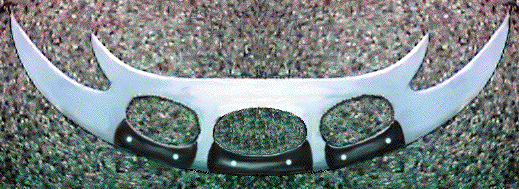
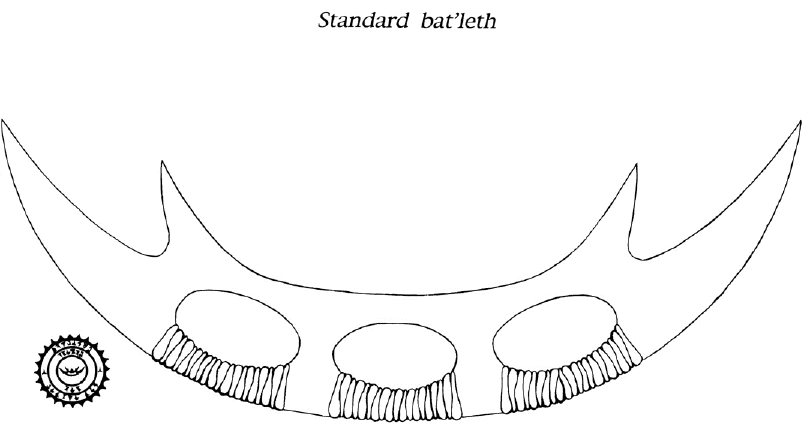


Excuse the delay of the start of this project due to back-ordered steel. Next month we'll have a lot more to go over IF the steel has come in by then. In the meantime, print the design up and reduce and alter the profile until it meets what you feel is a *do-able* project for you.
Qapla'!

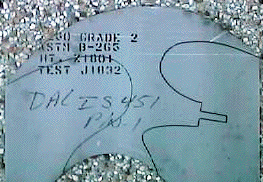
Next month .........
Remember to write with any material you'd like to have discussed or placed in
*mupwI'* ..
mupwI' yI'uchtaH !!
K'Daq
KIWG Main menu